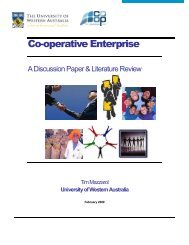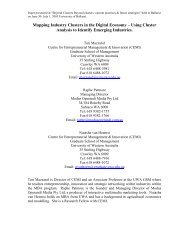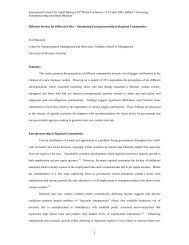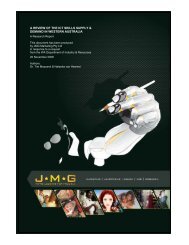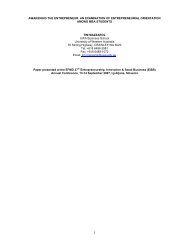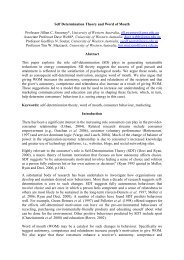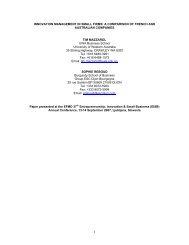The Third Wave: Future Trends in International Education - CEMI
The Third Wave: Future Trends in International Education - CEMI
The Third Wave: Future Trends in International Education - CEMI
Create successful ePaper yourself
Turn your PDF publications into a flip-book with our unique Google optimized e-Paper software.
Centre for Entrepreneurial Management and Innovation<br />
<strong>The</strong> <strong>Third</strong> <strong>Wave</strong>: <strong>Future</strong> <strong>Trends</strong> <strong>in</strong> <strong>International</strong> <strong>Education</strong><br />
11<br />
develop HR policies that will permit foreign branch campus staff to move freely <strong>in</strong>to their domestic faculty.<br />
Such global HR policies have been major issues for many organisations and educational <strong>in</strong>stitutions are not<br />
likely to be any different. Further, as such branch campuses expand, it is likely that staff will move between a<br />
number of countries, lead<strong>in</strong>g to a need for the appropriate recruitment, development and support of a group<br />
of ‘expatriate’ staff. ICT-based delivery models seem likely to supplement, rather than replace, the branch<br />
campus model. It is unlikely that such media will remove the need for face-to-face (F2F) <strong>in</strong>teraction,<br />
particularly <strong>in</strong> research and high quality teach<strong>in</strong>g environments, where ‘soft’ service is the key. However, ICT<br />
can be excellent facilitat<strong>in</strong>g media and most <strong>in</strong>stitutions will need to <strong>in</strong>vest <strong>in</strong> this technology if they are to<br />
rema<strong>in</strong> <strong>in</strong>ternationally competitive.<br />
CONCLUSIONS<br />
It is clear that the <strong>in</strong>ternationalisation of education has created a new market place that is very different to the<br />
local markets of recent memory. Competition has changed, as have competitors and education adm<strong>in</strong>istrators<br />
must come to grips with the risks and returns of complex <strong>in</strong>ternational environments. Rapidly chang<strong>in</strong>g<br />
technology has also meant that educational <strong>in</strong>stitutions are faced with some very significant <strong>in</strong>vestment<br />
decisions, especially given the tight resource constra<strong>in</strong>ts most face. Further, the chang<strong>in</strong>g environment has led<br />
to significant changes <strong>in</strong> staff responsibilities and there is a real need for changes <strong>in</strong> HR policies to reflect these<br />
changes. Until this occurs, staff are likely to f<strong>in</strong>d traditional factors are used to decide such issues as tenure<br />
and promotion, even though their work loads and environment look very different. <strong>Third</strong> wave educational<br />
<strong>in</strong>stitutions will need to work carefully to address these issues if they are to survive the ride.<br />
REFERENCES<br />
Agarwal, S., and Ramaswami, S.N. (1992). “Choice of Foreign Market Entry Mode: Impact of Ownership,<br />
Location and <strong>International</strong>ization Factors.” Journal of <strong>International</strong> Bus<strong>in</strong>ess Studies 23(1): 1-27.<br />
Allen, M. (1988). “Competitive Confrontation <strong>in</strong> Consumer Services.” Plann<strong>in</strong>g Review 17(1): 4-9.<br />
Altbach, P., Kelly, D., and Lulat, Y.G.M. (1985). Research on Foreign Students and <strong>International</strong> Study: An<br />
Overview and Bibliography. New York, Praeger.<br />
AMC (1993). Emerg<strong>in</strong>g Exporters: Australia's High Value Added Manufactur<strong>in</strong>g Exporters. Melbourne,<br />
Australian Manufactur<strong>in</strong>g Council.<br />
Anderson, E., and Coughlan, A.T. (1987). “<strong>International</strong> Market Entry and Expansion via Independent or<br />
Integrated Channels of Distribution.” Journal of Market<strong>in</strong>g 51: 71-82.<br />
Anderson, E., and Gatignon, H. (1986). “Modes of Entry: A Transactions Cost Analysis and Propositions.”<br />
Journal of <strong>International</strong> Bus<strong>in</strong>ess Studies 17(Fall): 1-26.<br />
Anderson, E., and Weitz, B. (1986). “Make or Buy Decisions: A Framework for Analys<strong>in</strong>g Vertical Integration<br />
Issues <strong>in</strong> Market<strong>in</strong>g.” Sloan Management Review 27(Spr<strong>in</strong>g): 3-19.<br />
Badr<strong>in</strong>ath, R. (1994). “Help<strong>in</strong>g Small and Medium-sized Firms to Enter Export Markets.” <strong>International</strong> Trade<br />
Forum 2: 4-29.<br />
Bartlett, T. (1997). “<strong>The</strong> Hottest Campus on the Internet.” Bus<strong>in</strong>ess Week 3549(October): 77-79.<br />
Centre for Entrepreneurial Management and Innovation | www.cemi.com.au



